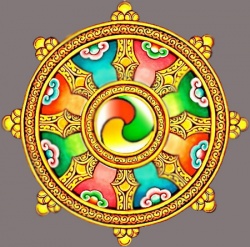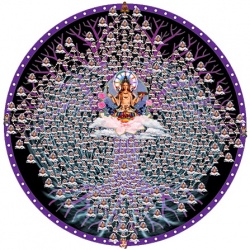Description of the Kālacakra calendar
Since first publishing the Kalacakra calendar on this website a few years ago, I have often been asked to make it more useful. Fulfilling these requests seems to consist in doing two things: first, including Chinese symbolic information, and thereby making the calendar more like a full Tibetan one; it effectively becomes a Tibetan calendar with accurate astronomy. Second, explaining the symbolic information included in the calendar. This will be done over a period of time, although a start has been made. See also here.
Combining the Kālacakra calendar with Chinese symbolic information is relatively straightforward, and the only complications are with regard to the naming of the months and the start of new year.
The Tibetan calendar systems that survive today were originally criticised by Indian experts for having the months wrong – the Tibetan month Caitra was a month later than that in India and Kashmir. The main reason for this is that most Tibetan calendar makers developed the idea that the winter solstice &ndash and other seasonal phenomena – are observed in Tibet about three weeks before they are observed in India. This is completely wrong, and the fact that this was built into their calculations caused their calendars to contain major errors.
However, in the system mentioned previously as following closely the methods of the Kālacakra, "Correction of Error" ('khrul sel), this was not the case. This makes the combination of the Chinese and Kālacakra systems straightforward, although it does lead to two new year definitions – one has to be chosen, and the Tibetans certainly followed the Chinese new year.
The first month of the Chinese year is the one during which the Sun enters Pisces, and the first month of the Kālacakra year is the following month, during which the Sun enters Aries. These are known respectively as the early- and mid-spring months.
Zhonnu Pal (gzhon nu dpal) is better known as the author of the famous historical work, The Blue Annals, translated by George Roerich. He was also a great expert on Kālacakra, but the "Correction of Error" calendar that he developed in the 15th century did not survive very long. However, the principles on which it was based followed the definitions of the Kālacakra Tantra closely, and defined and combined the months of the Indian and Chinese traditions in a way that would certainly have met with the approval of both Indian and Chinese experts. The calendar failed because of a combination of politics and an unfortunate error in the weekday definitions. It also included other errors, but these were not so important to the cycles of the days and months, and so it is certainly the best model to follow for a modern combination of the Kālacakra calendar with Chinese symbolism.
In the calendar presented here, both the Chinese and Kālacakra new years are indicated, and each month is also described in terms of both Chinese and Kālacakra systems.
For example, for the start of the Chinese new year in 2004, in the calendar for London, UK, the following information is given:
- Chinese New Year: Wood-male-Monkey, 2004.
- Numeric square: 5.
Wood-male-Monkey identifies the year from the Chinese 60-year cycle, and the Numeric square is also an item of Chinese symbolic information.
A month later, the Kālacakra new year is indicated, with:
Kālacakra New Year: Bhanutara, 2004.
The word Bhanutara is the name of the year from the Indian 60-year cycle.
For the months, the Chinese details are given first – an element combined with one of the twelve animals and the seasonal name for the month. Next is the Kālacakra information, including the name of the month and the zodiacal sign that defines it. For the first month of 2004, the following is given:
- Chinese Month: 1, Fire-Tiger, Early-Spring.
- Kālacakra Month: 12, Phalguna, Pisces.
The month concerned is the first in the new Chinese year, and the last in the old Kālacakra year, and for these reasons is numbered 1 and 12 respectively. The Tibetans derived their month numbering from the Mongolians who also used the Chinese system. In this present calendar, the Tibetan month numbering would be equivalent to the Chinese month numbers. Fire-Tiger is the Chinese element and animal combination. Phalguna is the name of the month from the Indian system, equivalent to the approximate lunar mansion in which full Moon occurs, and Pisces is the sign the Sun enters during the month – it is this that defines the month, both for the Chinese and Kālacakra systems.
For the daily information, most entries contain four lines, although there are special cases with extra lines. The first two lines give western and Kālacakra information, and the next two lines give Chinese information for the day concerned.
In the example of the first day of the Chinese year of 2004, the following information is given:
- 1. Sat, 21 Feb 2004. Uttarabhadrapada, 19:8:5: Revati; Shubha, Vava.
- Earth-Water -> Earth-Water, control -> humanity.
- Earth-Tiger, Li 1 Sat Niu
- Solar: Iron-Horse. Wei, Dwa 1
- zin phung
On the first line, the first numeral "1" represents the lunar date. There then follows the weekday and the western date. Next, Uttarabhadrapada is the lunar mansion in which the Moon was positioned at daybreak. If the lunar mansion changes during the day, and on this day it does, then this is followed by a time, 19:8:5, and the name of the new lunar mansion, Revati, that the Moon enters at that time. The time is given in terms of nadi, pala and breaths from mean daybreak. There are 60 nāḍī in a solar day, each nāḍī consists of 60 pala, and each pala consists of 6 breaths. 19:8:5 therefore refers to 7 hours, 39 minutes, 32 seconds after daybreak (5.00am LMST). This therefore refers to a time of 12.39 – just after noon – Local Mean Solar Time.
Still on the first line, Shubha is the name of the Yoga at daybreak, and Vava is the karaṇa.
On the second line, symbolic information is given which is associated with the combination of the weekday and lunar mansion. Both of these items are considered important in considering the astrological significance of the day. As on the line above, the change of lunar mansion during the day is taken into account. First the pairings of the elements associated with the weekday and lunar mansion are given, and then one of a list of 28 combinations (yogas) between the weekday and mansion, independant of the elements concerned. A list of these is given on this page.
On the third line Chinese symbolic information is given for the lunar day concerned. Earth-Tiger is the element-animal combination, Li is one of the eight trigrams, and 1 is one of the nine numbers. The next two items are rarely given in Tibetan almanacs for lunar days, but they are used in Tibetan astrology and so they are included here. Sat is short for Saturday and is a cyclic planet (weekday) for the lunar day. These cycle in a very similar manner to the normal weekdays. Niu is a cyclic lunar mansion associated with the lunar day. This lunar mansion name is given in Chinese transliteration, as is that on the next line.
The lunar mansion given on line three is based on a similar principle to the naming convention described earlier for the Indian months – those months are named after the approximate lunar mansion in which full Moon occurs. This is similar, and the original intention seems to have been to approximate the actual lunar mansion that the Moon would be in on any particular lunar day.
The fourth line gives similar information for the solar day concerned. After the element-animal pair, Wei, is a lunar mansion associated with the solar day. Dwa is a trigram and 1 is again one of the nine numbers. This solar information, apart from the lunar mansion, should be the same as given in Chinese almanacs.
The final line in this example contains the phrase: zin phung. This is the name of one of the many earth-lords that are considered in the Tibetan version of Chinese astrology, and zin-phung is considered active on this day. This particular information has been requested by a group using this calendar.
Alternatively, the final lines in a set of daily information will include details of special commemorative days, timing of new and full Moons, and timing of the changes of sign of the mean Sun – it is this that defines the months.
Since June 2005 eclipse information has been added to the details given in the calendar. (Thanks to Mingyur Rinpoche for pointing out that this should be included.) Basic information about the type of any eclipse that occurs and its magnitude is given on the last line of daily information. Naturally, eclipses can only occur on the 15th or 30th lunar day of a month. No details are given in this calendar regarding the visibility of any eclipse. Anybody needing more detailed information about any eclipse should look at other sources, such as the pages put together by Fred Espenak on the NASA website.
Many people have requested that the meaning of these various symbolic attributes should be given with this calendar, and over time these details will be added. In the meantime, please refer to here for an initial list of the symbolic information, and to here for the as yet incomplete notes on the astrology associated with the calendar.
Problems with the calendar
There are a couple of unresolved concerns with the calendar published on this site. The combination of the Chinese and Kālacakra systems does not pose any real difficulty. The intentions behind the Tibetan attempts to make this combination are clear enough; the two systems are sufficiently compatible to make this straightforward; and, there is the excellent example of the calendar devised by Zhonnu Pal.
There are however two important issues with regard to the Kālacakra calendar, both of which require further research before they can be finally settled, if that will ever be possible. They both relate to the definition of the months.
The months are defined by the Sun entering one of the signs of the zodiac. This is also the case in the Chinese calendar, and it appears that the Chinese were influenced in this by Indian Buddhist calendrical experts.
However, the texts that survive that describe the Kālacakra calendar make use of the mean motion of the Sun for determining months, not the true Sun. It is possible that if the tradition had continued in use in India, it would have evolved to have used the true Sun. Some other Indian systems did eventually use the true Sun, as did the Chinese calendar since the reform of 1645 C.E. But use of the true Sun introduces problems.
If the mean Sun is used to determine the months, then there is a fairly regular occurance every 32 or 33 months of an intercalary month – a month during which the Sun does not change sign. If the true Sun is used however, there are years when this regularity breaks down, and months can occur when the Sun changes sign twice, and years can occur when during two months the Sun does not change sign.
The Chinese system has devised some rules for coping with this problem. See the excellent article by Helmer Aslaksen on the mathematics of the Chinese calendar in general and this problem in particular.
As there is no discussion in the Kālacakra literature on this topic, the calendar published on this site uses the mean Sun for the month definitions. For comparison purposes, a version of the software is also available here that uses the true Sun for the month definitions. This is not used for the calculation of the calendars published here.
The second unresolved issue concerns the definitions that are applied to the intercalary, or extra, month. The calendar published here follows the normal Tibetan tradition, and the intercalary month has the number and other attributes of the month that follows it. However, some Tibetans favoured the other method where the intercalary month has the name and number of the month that preceeds it.
The mathematics of the calendar devised by Zhonnu Pal strongly suggests that he also used this method, which is also the same method used in China. Unfortunately the Kālacakra literature does not spell this out unambiguously, although it does cetainly seem that the Kālacakra system followed the previous month naming convention. Assuming this to be the case, then the question remains just why the Tibetans changed this. For now, at least, the calendar published here follows the main Tibetan system.
There is a very strong logic to the method of naming the intercalary month after the previous month. If a month is defined by entry into a particular sign, if the next month is intercalary, then the Sun does not change sign and remains in that same sign for the whole of that month. It would make sense for that intercalary month to be named after the sign that the Sun is actually in during the month, rather than the sign that it will move into during the following month. However, the latter method is in general use in Tibet.
It is possible that the Tibetan system was influenced by other, non-Buddhist, Indian systems. It appears that some defined the months by the sign that the Sun is in at the time of the new Moon that begins the month. This means that the new Moon at the beginning of an intercalary month would happen when the Sun is at the very beginning of a particular sign, and the following new Moon would occur when the Sun is at the very end of that same sign. This is not how the months are defined in the Kālacakra literature, but this kind of definition reverses the logic and suggests that the intercalary month should have the same name and characteristics as the month following it. Perhaps the Tibetans originally followed such a system.
There is one final small point worth mentioning. A month is defined by the change of sign of the Sun. For this definition is the month taken as the period between exact new Moon and the next new Moon, or is it daybreak immediately following one new Moon until daybreak immediately following the next new Moon? Many of the months will have different names depending on which of these methods are used.
The Kālacakra literature again does not spell this out unambiguously, but the calculations make the definition reasonably clear. The month number and name are defined by the change of Sun sign between two new Moons, but the months themselves consist of whole solar days, and the first day is the one following new Moon – new Moon occurs on the last solar day of any month. This is sufficiently clear in the literature, and so the calendars on this site follow this method, but it is worth bearing in mind that this is yet another factor that could change the structure of the final calendar.
Accuracy of the calendar
The structure of the Kālacakra calendar depends upon the calculation of the longitudes of the Sun and the Moon at mean daybreak (5.00am Local Mean Solar Time) for the chosen geographical location. The calculations used for the longitude of the Sun are the VSOP87 solution, devised by P. Bretagnon and G. Francou. The data used for these calculations are to be found here.
These calculations are an algebraic solution to the modern numerical integration techniques developed by the Jet Propulsion Laboratory, as are the calculations used for the longitude of the Moon. These were based in earlier versions of this software on algebraic methods given in "Lunar Tables and Programs from 4000 B.C. to A.D. 8000", by Michelle Chapront-Touzé and Jean Chapront. The calculations were again a C language implementation of these algorithms and were a little less accurate than those for the Sun. They have now been replaced by the more recent, and more accurate, solution, ELP/MPP02. Further information is available here.
The results of calculations for both the Sun and the Moon have been extensively checked against examples given by NASA and by Chapront-Touzé and Chapront. In checking the error during the last 3,000 years it was found that the error in deltaT – the difference between Dynamical Time and Universal Time – was greater than the error in the calculations themselves. It seems therefore that further precision, if such becomes possible in the future, would have little meaning in this context.
Zhonnu Pal
Many thanks to Dr. Klaus-Dieter Mathes for permission to use the line drawing on this page of Zhonnu Pal. This image appears on the front cover of Dr. Mathes' recent publication of the Tibetan text of the "theg pa chen po rgyud bla ma'i bstan bcos kyi 'grel bshad de kho na nyid rab tu gsal ba'i me long", by "'gos lo tsā ba gzhon nu dpal". This is published by Franz Steiner Verlag, Stuttgart.
E Henning



